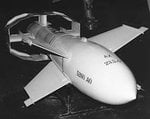A
Anonymous
Guest
GermansRGeniuses said:You seem to not have gotten the point...
It could have been dropped by an He-177, a jet bomber, or anything that could carry it...
As it is indeed a rocket, more so than a missle, it could be released at a dive, in a roughly 45 degree angle to pierce a ship's top armor, though I am saying it could be used to mount a guidance system due to its size...
That was not the intent of the weapon. An He-177 trying to attack an Allied ship as you describe would likely be a dead plane, it would have to get too close. And from such a range, why would it need a rocket motor giving 6 minutes of thrust?
The idea of these weapons was to release them outside of enemy AAA range and then guide them into the target. For that, perhaps 45 seconds of thrust is more than enough. Because the weapon is going to be in decent the whole way to the target, it does not need the thrust to lift it 30,000 feet into the air in 3 minutes, so this dicates the motor should be smaller as well.
The Hs292 weighed about 3000 lbs. The Me163 weighed about 9000 lbs. To justify using the Me163 engine on a larger scale Hs292 type missile, the missile would have had to weigh something on the order of 20000 lbs or more, and no German bomber could carry such a weapon.
The He177 could carry two Hs292's, so it might be able to carry a weapon weighing about 10000 lbs - maybe. Put the Me163 engine on that, and it would go so fast the person operating it would have almost no chance to actually guide it into the target, and it would have enough fuel to go 50+ miles to a target, but it would be out of the operators range within 5 miles. What's the point of that?
=S=
Lunatic






